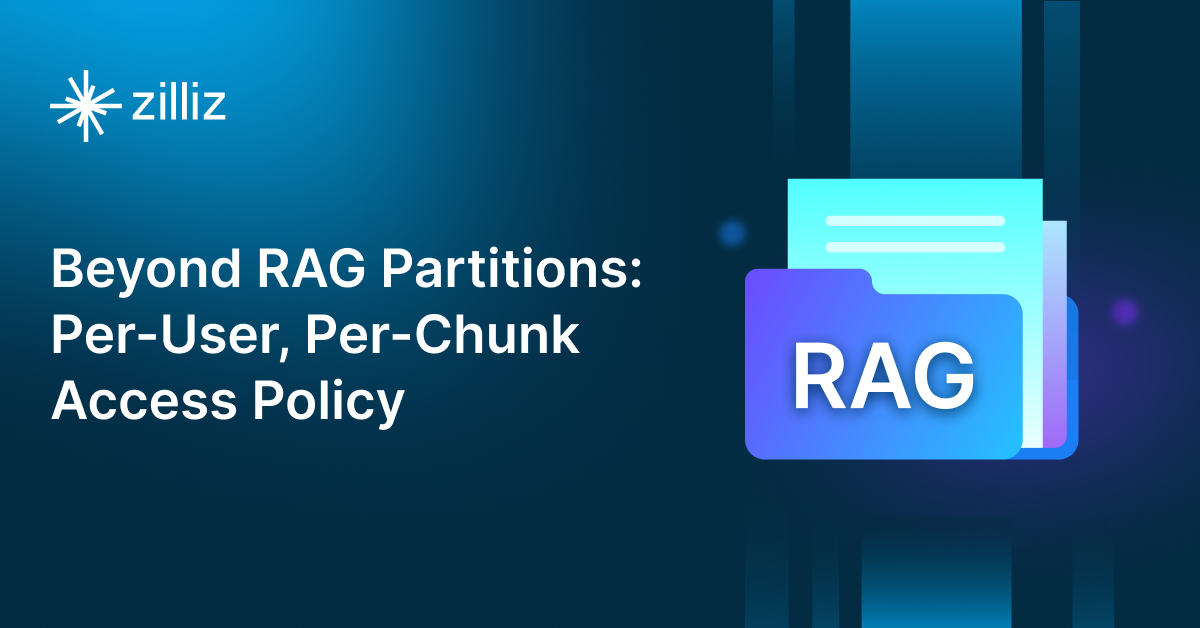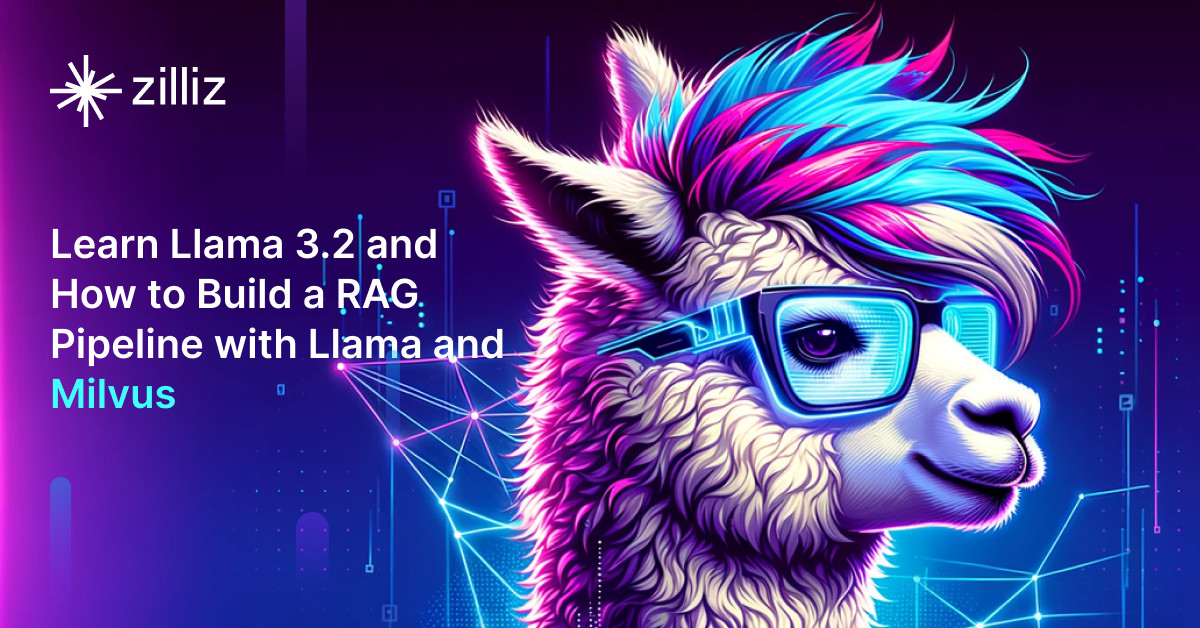Build RAG Chatbot with LangChain, pgvector, Cohere Command, and OpenAI text-embedding-3-large
Introduction to RAG
Retrieval-Augmented Generation (RAG) is a game-changer for GenAI applications, especially in conversational AI. It combines the power of pre-trained large language models (LLMs) like OpenAI’s GPT with external knowledge sources stored in vector databases such as Milvus and Zilliz Cloud, allowing for more accurate, contextually relevant, and up-to-date response generation. A RAG pipeline usually consists of four basic components: a vector database, an embedding model, an LLM, and a framework.
Key Components We'll Use for This RAG Chatbot
This tutorial shows you how to build a simple RAG chatbot in Python using the following components:
- LangChain: An open-source framework that helps you orchestrate the interaction between LLMs, vector stores, embedding models, etc, making it easier to integrate a RAG pipeline.
- Pgvector: an open-source extension for PostgreSQL that enables efficient storage and querying of high-dimensional vector data, essential for machine learning and AI applications. Designed to handle embeddings, it supports fast approximate nearest neighbor (ANN) searches using algorithms like HNSW and IVFFlat. Since it is just a vector search add-on to traditional search rather than a purpose-built vector database, it lacks scalability and availability and many other advanced features required by enterprise-level applications. Therefore, if you prefer a much more scalable solution or hate to manage your own infrastructure, we recommend using Zilliz Cloud, which is a fully managed vector database service built on the open-source Milvus and offers a free tier supporting up to 1 million vectors.)
- Cohere Command: Cohere Command is a powerful language model designed for task-oriented applications, emphasizing efficiency and scalability. It excels in generating contextual responses, deploying natural language processing tasks like text generation, summarization, and query answering. Ideal for businesses looking to enhance customer interactions and automate workflows with accurate and relevant outputs.
- text-embedding-3-large: OpenAI's text embedding model, generating embeddings with 1536 dimensions, designed for tasks like semantic search and similarity matching.
By the end of this tutorial, you’ll have a functional chatbot capable of answering questions based on a custom knowledge base.
Note: Since we may use proprietary models in our tutorials, make sure you have the required API key beforehand.
Step 1: Install and Set Up LangChain
%pip install --quiet --upgrade langchain-text-splitters langchain-community langgraph
Step 2: Install and Set Up Cohere Command
pip install -qU "langchain[cohere]"
import getpass
import os
if not os.environ.get("COHERE_API_KEY"):
os.environ["COHERE_API_KEY"] = getpass.getpass("Enter API key for Cohere: ")
from langchain.chat_models import init_chat_model
llm = init_chat_model("command", model_provider="cohere")
Step 3: Install and Set Up OpenAI text-embedding-3-large
pip install -qU langchain-openai
import getpass
import os
if not os.environ.get("OPENAI_API_KEY"):
os.environ["OPENAI_API_KEY"] = getpass.getpass("Enter API key for OpenAI: ")
from langchain_openai import OpenAIEmbeddings
embeddings = OpenAIEmbeddings(model="text-embedding-3-large")
Step 4: Install and Set Up pgvector
pip install -qU langchain-postgres
from langchain_postgres import PGVector
vector_store = PGVector(
embeddings=embeddings,
collection_name="my_docs",
connection="postgresql+psycopg://...",
)
Step 5: Build a RAG Chatbot
Now that you’ve set up all components, let’s start to build a simple chatbot. We’ll use the Milvus introduction doc as a private knowledge base. You can replace it with your own dataset to customize your RAG chatbot.
import bs4
from langchain import hub
from langchain_community.document_loaders import WebBaseLoader
from langchain_core.documents import Document
from langchain_text_splitters import RecursiveCharacterTextSplitter
from langgraph.graph import START, StateGraph
from typing_extensions import List, TypedDict
# Load and chunk contents of the blog
loader = WebBaseLoader(
web_paths=("https://milvus.io/docs/overview.md",),
bs_kwargs=dict(
parse_only=bs4.SoupStrainer(
class_=("doc-style doc-post-content")
)
),
)
docs = loader.load()
text_splitter = RecursiveCharacterTextSplitter(chunk_size=1000, chunk_overlap=200)
all_splits = text_splitter.split_documents(docs)
# Index chunks
_ = vector_store.add_documents(documents=all_splits)
# Define prompt for question-answering
prompt = hub.pull("rlm/rag-prompt")
# Define state for application
class State(TypedDict):
question: str
context: List[Document]
answer: str
# Define application steps
def retrieve(state: State):
retrieved_docs = vector_store.similarity_search(state["question"])
return {"context": retrieved_docs}
def generate(state: State):
docs_content = "\n\n".join(doc.page_content for doc in state["context"])
messages = prompt.invoke({"question": state["question"], "context": docs_content})
response = llm.invoke(messages)
return {"answer": response.content}
# Compile application and test
graph_builder = StateGraph(State).add_sequence([retrieve, generate])
graph_builder.add_edge(START, "retrieve")
graph = graph_builder.compile()
Test the Chatbot
Yeah! You've built your own chatbot. Let's ask the chatbot a question.
response = graph.invoke({"question": "What data types does Milvus support?"})
print(response["answer"])
Example Output
Milvus supports various data types including sparse vectors, binary vectors, JSON, and arrays. Additionally, it handles common numerical and character types, making it versatile for different data modeling needs. This allows users to manage unstructured or multi-modal data efficiently.
Optimization Tips
As you build your RAG system, optimization is key to ensuring peak performance and efficiency. While setting up the components is an essential first step, fine-tuning each one will help you create a solution that works even better and scales seamlessly. In this section, we’ll share some practical tips for optimizing all these components, giving you the edge to build smarter, faster, and more responsive RAG applications.
LangChain optimization tips
To optimize LangChain, focus on minimizing redundant operations in your workflow by structuring your chains and agents efficiently. Use caching to avoid repeated computations, speeding up your system, and experiment with modular design to ensure that components like models or databases can be easily swapped out. This will provide both flexibility and efficiency, allowing you to quickly scale your system without unnecessary delays or complications.
pgvector optimization tips
To optimize pgvector in a Retrieval-Augmented Generation (RAG) setup, consider indexing your vectors using GiST or IVFFlat to significantly speed up search queries and improve retrieval performance. Make sure to leverage parallelization for query execution, allowing multiple queries to be processed simultaneously, especially for large datasets. Optimize memory usage by tuning the vector storage size and using compressed embeddings where possible. To further enhance query speed, implement pre-filtering techniques to narrow down search space before querying. Regularly rebuild indexes to ensure they are up to date with any new data. Fine-tune vectorization models to reduce dimensionality without sacrificing accuracy, thus improving both storage efficiency and retrieval times. Finally, manage resource allocation carefully, utilizing horizontal scaling for larger datasets and offloading intensive operations to dedicated processing units to maintain responsiveness during high-traffic periods.
Cohere Command optimization tips
Cohere Command is a general-purpose language model that can be optimized for RAG workflows through prompt engineering, efficient retrieval, and structured response control. To improve accuracy, use Cohere’s reranking capabilities to filter and prioritize retrieved documents before passing them into the model. Keep input prompts concise and structured, reducing token overhead while ensuring clear context for the model. Optimize response quality by adjusting parameters such as temperature (0.1–0.3 for factual accuracy) and top-p sampling to control creativity levels. Implement hybrid search techniques by combining dense and sparse retrieval methods to improve recall and precision. For cost-efficient scaling, cache frequently queried responses and precompute embeddings for common knowledge areas. Stream responses where real-time generation is required, minimizing latency while ensuring user engagement. Monitor API usage and latency through Cohere’s analytics tools to fine-tune retrieval strategies based on performance trends.
OpenAI text-embedding-3-large optimization tips
OpenAI text-embedding-3-large is a high-capacity embedding model designed for precise and rich semantic representation, making it ideal for RAG systems with complex document retrieval needs. Optimize efficiency by preprocessing and normalizing text to reduce noise before embedding generation. Use dimensionality reduction techniques, such as PCA, if storage or computational limits become a concern. When querying, leverage HNSW-based approximate nearest neighbor (ANN) search to accelerate retrieval while maintaining accuracy. Batch process embedding requests to reduce latency and optimize resource utilization. Implement re-ranking models to further refine top results based on query context. Regularly update the embedding store with newly ingested data to maintain retrieval relevance.
By implementing these tips across your components, you'll be able to enhance the performance and functionality of your RAG system, ensuring it’s optimized for both speed and accuracy. Keep testing, iterating, and refining your setup to stay ahead in the ever-evolving world of AI development.
RAG Cost Calculator: A Free Tool to Calculate Your Cost in Seconds
Estimating the cost of a Retrieval-Augmented Generation (RAG) pipeline involves analyzing expenses across vector storage, compute resources, and API usage. Key cost drivers include vector database queries, embedding generation, and LLM inference.
RAG Cost Calculator is a free tool that quickly estimates the cost of building a RAG pipeline, including chunking, embedding, vector storage/search, and LLM generation. It also helps you identify cost-saving opportunities and achieve up to 10x cost reduction on vector databases with the serverless option.
 Calculate your RAG cost
Calculate your RAG cost
What Have You Learned?
By now, you’ve seen firsthand how powerful it is to bring together cutting-edge tools to create a RAG system that feels almost magical! You learned how LangChain acts as the glue, orchestrating the entire pipeline by seamlessly connecting your data sources, retrieval logic, and language model. With pgvector as your vector database, you unlocked the ability to store and query embeddings at scale, turning unstructured text into searchable knowledge. The OpenAI text-embedding-3-large model gave your data superpowers, transforming words into rich numerical representations that capture meaning and context—like giving your system a sixth sense for semantic relationships. And when it came time to generate responses, Cohere Command stepped in with its knack for natural, coherent answers, turning retrieved context into human-like dialogue. Together, these components form a dynamic loop: retrieve, understand, generate, repeat!
But this tutorial didn’t stop at the basics. You also picked up pro tips for optimizing performance, like tweaking chunk sizes for embeddings or balancing speed vs. accuracy in retrieval. And that free RAG cost calculator? A game-changer for budgeting your experiments without surprises. Now imagine what you can build next—whether it’s a customer support bot that knows your docs inside-out, a research assistant that surfaces insights from mountains of data, or something entirely new. The tools are in your hands, the concepts are clear, and the possibilities are endless. So go ahead—fire up your IDE, experiment fearlessly, and let your creativity run wild. The future of intelligent apps is yours to shape, one RAG-powered innovation at a time. Let’s build something amazing! 🚀
Further Resources
🌟 In addition to this RAG tutorial, unleash your full potential with these incredible resources to level up your RAG skills.
- How to Build a Multimodal RAG | Documentation
- How to Enhance the Performance of Your RAG Pipeline
- Graph RAG with Milvus | Documentation
- How to Evaluate RAG Applications - Zilliz Learn
- Generative AI Resource Hub | Zilliz
We'd Love to Hear What You Think!
We’d love to hear your thoughts! 🌟 Leave your questions or comments below or join our vibrant Milvus Discord community to share your experiences, ask questions, or connect with thousands of AI enthusiasts. Your journey matters to us!
If you like this tutorial, show your support by giving our Milvus GitHub repo a star ⭐—it means the world to us and inspires us to keep creating! 💖
- Introduction to RAG
- Key Components We'll Use for This RAG Chatbot
- Step 1: Install and Set Up LangChain
- Step 2: Install and Set Up Cohere Command
- Step 3: Install and Set Up OpenAI text-embedding-3-large
- Step 4: Install and Set Up pgvector
- Step 5: Build a RAG Chatbot
- Optimization Tips
- RAG Cost Calculator: A Free Tool to Calculate Your Cost in Seconds
- What Have You Learned?
- Further Resources
- We'd Love to Hear What You Think!
Content
Vector Database at Scale
Zilliz Cloud is a fully-managed vector database built for scale, perfect for your RAG apps.
Try Zilliz Cloud for Free


